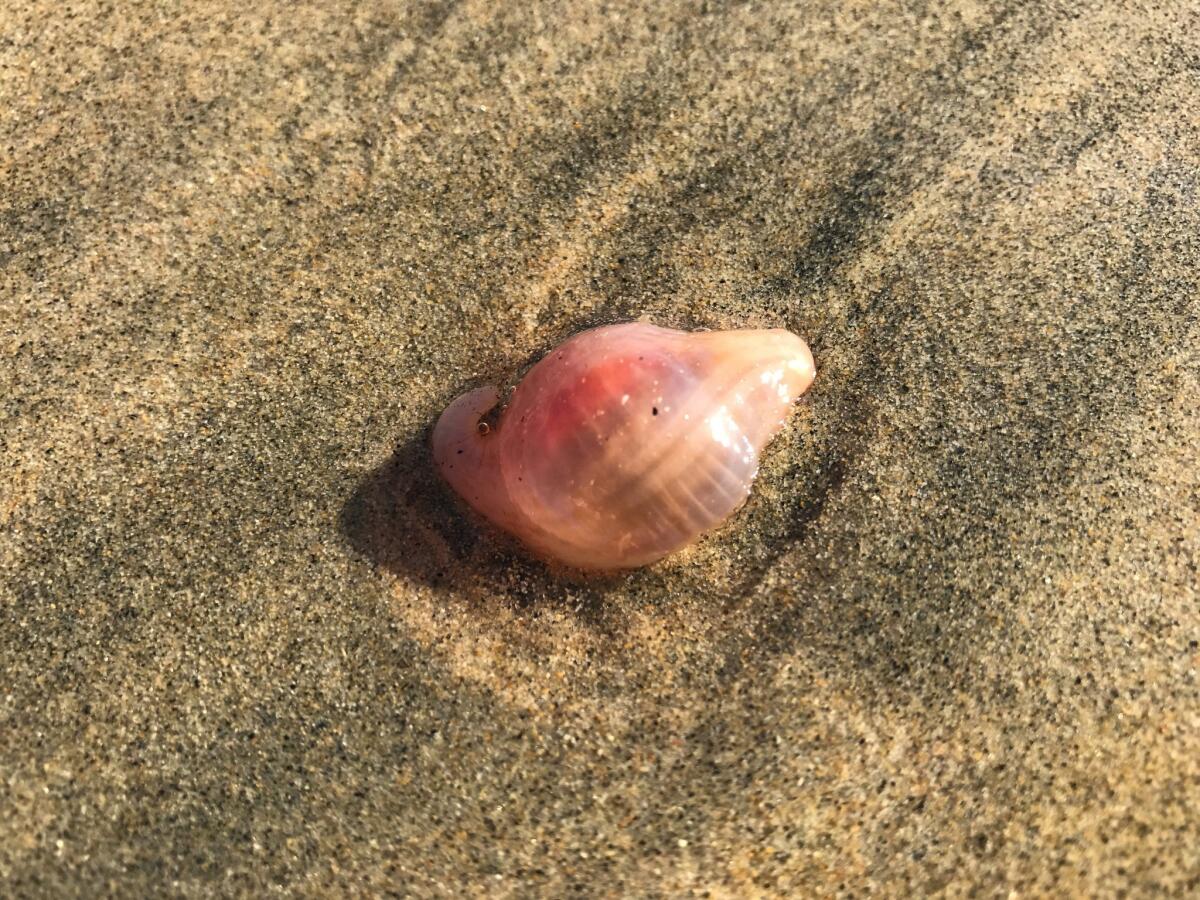Snakes, tiny crabs and other creatures: Why the ocean sends us unusual visitors

Sea cucumbers washed up in Huntington Beach in December.
- Share via
On an overcast December day, Kimberly Bryner was taking a walk down the Huntington Beach shoreline with her daughter when she stumbled upon small, gelatinous masses being picked apart by swarms of strafing seagulls.
“They were like little glass balls all up and down the beach,” Bryner said. “My daughter and I thought they may be a type of jellyfish but could tell they held some sort of embryo inside.”
The bloated creatures lay limp and unmoving on the sand. Bryner picked one up and held it in the palm of her hand.
“They were like a very firm gelatin in feel and texture,” Bryner said.
After a day or two, the tide came in and pulled what remained of the gulls’ feast back into the sea.
The creatures were sea sweet potatoes, or Molpadia arenicola, as scientists call them. They are a type of sea cucumber fairly common off the coast of the western United States. Being burrowing creatures, though, they are seldom seen by humans unless harsh conditions force them from where they dwell beneath the sand.
After storms swept Southern California from late November through December, Molpadia arenicola wriggled free of their lodgings in the ocean floor and cast themselves into the sea currents in search of waters more agreeable to their delicate bodies, only to wash up on beaches along the coast of Southern California as far south as San Diego.
The invasion was a reminder that for all the surfers, swimmers, joggers and sunbathers who use Orange County’s beaches, that they are far from alone. The sea sweet potatoes mark the latest in a dance along the coast between humans and sealife, some of it decidely weird.
Though Huntington Beach Marine Safety Lt. Claude Panis hasn’t seen sea cucumbers like these wash up in the city before, he said he has seen a similar invasion of displaced marine animals.
Last year, Huntington Beach was carpeted in tiny red tuna crabs, each 1 to 3 inches long.
“We had thousands of them washing up,” Panis said. “Alive.”
Many Southern Californian beaches had so many of the crabs that the sand nearest to the water was completely covered in squirming red carapaces.
In 2015, a more unsettling creature started washing up on California shores, though not in similar numbers: the yellow-bellied sea snake, which usually inhabits more tropical waters along the Mexican coast. On beaches across Southern California, the venomous snakes were found on the sand, dead or barely alive.
All of these creatures — sea sweet potatoes, tuna crabs and yellow-bellied sea snakes — are understood in marine biology. They are not rare or previously unknown species, as many beachgoers have speculated. Why, though, have they all ventured so far from their original habitats only to die on the shore?
Each case is the result of significant environmental shifts in the ocean. The tuna crabs and yellow-bellied sea snakes probably made their way to Californian shores because of warm water currents brought on by El Niño. The sea snakes and the crabs are typically found off the northwest coast of Mexico, and strong currents from the south during El Niño would have pushed them northward in an aquatic pell-mell.
The sea cucumbers, however, had different reasons for leaving their dwellings at the bottom of the sea. According to Matthew Bracken, associate professor of ecology and evolutionary biology at UC Irvine, the sea cucumbers were probably disturbed by the rain and stormy weather that hit Huntington and the surrounding waters a few days before the creatures’ demise.
“They don’t have excretory systems to osmoregulate,” said Bracken, “so they are stressed when a big rain flushes a lot of fresh water into the near-shore ocean.”
It was a flight from inhospitable waters, not an Atlantean colonization of earth, that caused the sea sweet potatoes to wash up on Huntington Beach. And though they were an unfamiliar sight for beachgoers like Bryner, they were not the first and they will not be the last.


